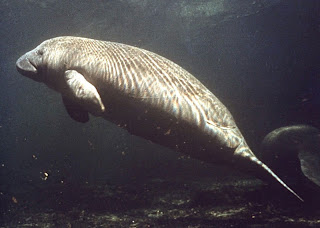 |
| Trichechus manatus |
The West Indian Manatee is one of the three living Manatees, with the African and the Amazonian being the other two. Though they live exclusively in the water like Whales do, they aren't closely related at all. Their nearest living relatives are actually the other members of the Afrotheria superorder- Elephants, Hyraxes, Sengis, and Aardvarks. The Manatees and Dugongs evolved from wading African herbivores millions of years ago.
 |
| West Indian Manatee eating |
Did you know that the West Indian Manatee is a migratory species? Though they normally only travel at around 5mph (a very brisk walking speed for a human), they can move hundreds of miles in a year. In the United States they have been seen as far north as Massachusetts and New York over the summer months, though those occurrences are very rare.
West Indian Manatees live long, slow lives when compared to some other mammals. They can live as long as 60 years, they have long gestation periods (up to 14 months), and very lengthy reproductive cycles that can mean several years between calves.
The slow reproductive rate has been one of the things holding back the conservation effort. You see, West Indian Manatees were once hunted for their meat, skins, and oil, and they continue to be threatened by fast moving watercraft and by habitat loss. They are listed as Vulnerable by the IUCN, and are protected by the United States Endangered Species act, but it is a a very slow path to recovery, since they breed so slowly and because the human population in their area only continues to grow.
IUCN Status : Vulnerable
Location : South America and Caribbean Islands
Size : Length up to 11ft (3.5m), Weight up to 1,200lbs (544kg)
Classification : Phylum : Chordata
-- Class : Mammalia -- Order : Sirenia
Family : Trichechidae -- Genus : Trichechus -- Species : T. manatus
Family : Trichechidae -- Genus : Trichechus -- Species : T. manatus
Comments
Post a Comment